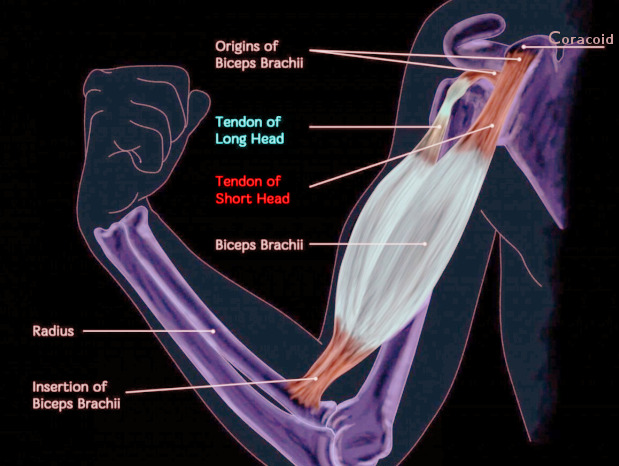Distal Biceps Tendon Repair
Overview
Distal biceps tendon repair surgery is performed to reattach a torn biceps tendon at the elbow. This type of injury is uncommon and typically results from a sudden trauma. A biceps tendon tear at the elbow tends to result in more problems than injuries to the biceps tendon at the shoulder.
Without surgical intervention, patients may experience significant loss of strength and function in the affected arm. The surgery aims to restore full mobility and strength, enabling patients to return to their usual activities.
Anatomy

Copyright © 2020, StatPearls Publishing LLC. Link to Image License: https://creativecommons.org/licenses/by/4.0/
The biceps muscle (Biceps Brachii), located at the front of the upper arm, is essential for bending the elbow and rotating the forearm. It connects to the shoulder (proximal attachment) and the elbow (distal attachment) via tendons. The distal biceps tendon attaches the muscle to the radius bone in the forearm. This tendon plays a critical role in arm movements, providing necessary strength and stability.
What is Distal Biceps Tendon Repair?
Distal biceps tendon repair surgery involves reattaching the torn tendon to the radius bone in the forearm. The procedure begins with an incision at the front of the elbow. The surgeon locates the torn tendon and prepares the bone for reattachment. A small metal button and strong sutures are used to dock the tendon into the bone, ensuring a stable and durable repair. The surgery typically lasts less than one hour and is often performed on an outpatient basis.
Types of Distal Biceps Tendon Repair Techniques
Several techniques can be used for distal biceps tendon repair, selected based on the patient’s specific needs:
- Single-Incision Technique: A single incision is made at the front of the elbow to access and repair the tendon.
- Double-Incision Technique: Two smaller incisions are made, one at the front and one at the back of the elbow, to reduce the risk of nerve damage.
- Suture Anchor Technique: Suture anchors are used to attach the tendon to the bone, providing strong and reliable fixation.
Conditions that may require this surgery
Distal biceps tendon repair may be necessary in cases of:
- Acute Rupture: A sudden tear caused by lifting a heavy object or a traumatic injury.
- Partial Tear: A partial tear that progresses to a full rupture over time due to repetitive strain or degeneration.
- Failed Non-Surgical Treatment: When conservative treatments like rest, physiotherapy, and bracing fail to alleviate symptoms or restore function.
Benefits and Risks
The main benefit of distal biceps tendon repair is the restoration of strength and function in the affected arm. However, like any surgery, there are risks involved, including infection, nerve damage, stiffness, and the potential for a recurrence of the tendon tear.
What Should I Expect?
Before the Procedure
Before the surgery, a thorough medical evaluation is conducted, including imaging studies such as MRI or ultrasound to assess the extent of the tendon tear. Dr. Soong Chua will assess your condition and may consider non-surgical treatment for those who are less active, have an injury to the non-dominant arm, or are in situations where reduced strength can be tolerated. Patients are also advised to avoid certain medications and to arrange for assistance during the recovery period.
During the Procedure
The procedure is usually performed under general or local anaesthesia. Mr Chua makes the necessary incisions, locates the torn tendon, and secures it to the radius bone using a metal button and screw or suture anchors. The incisions are then closed, and a splint or cast is applied to immobilise the arm.
After the Procedure
Post-operative care involves managing pain with medication, keeping the arm elevated to reduce swelling, and following a prescribed rehabilitation program.
A biceps tendon repair can take over 3 months to heal and longer to regain full strength, so it is important that you follow Mr. Soong Chua’s treatment plan and protect the repair by limiting your activities.
Physiotherapy typically begins a few weeks after surgery, focusing on gentle range-of-motion exercises that progress to strengthening exercises over time.
Frequently Asked Questions
- How long is the recovery period after distal biceps tendon repair?
Recovery generally takes about three to six months. A biceps tendon repair can take over 3 months to heal and longer to regain full strength, so it is important to follow Mr. Soong Chua’s treatment plan and protect the repair by limiting your activities. Adherence to the rehabilitation programme and the severity of the injury will also influence recovery time. - How long will I need to wear a splint or cast after the surgery?
After distal biceps tendon repair surgery, you may need to wear a splint or cast for approximately two weeks to immobilise the arm and allow initial healing. The exact duration will be determined by Mr. Soong Chua based on your specific condition and progress. - Will I regain full strength after the surgery?
Most patients regain full strength and function, although this depends on the severity of the tear and the success of the rehabilitation process. - Can the tendon tear again after the surgery?
While the risk of re-tearing is relatively low, it is important to follow the post-operative care plan and avoid activities that could strain the tendon during recovery.

